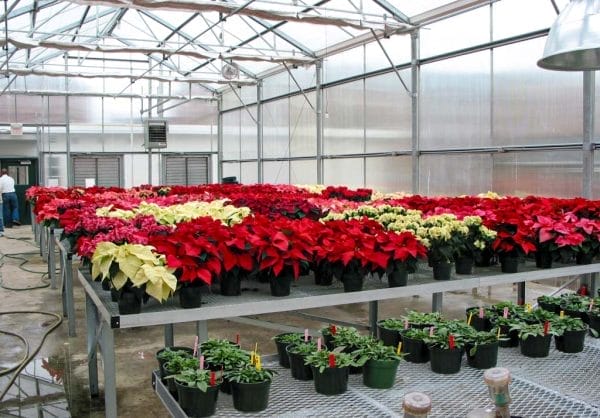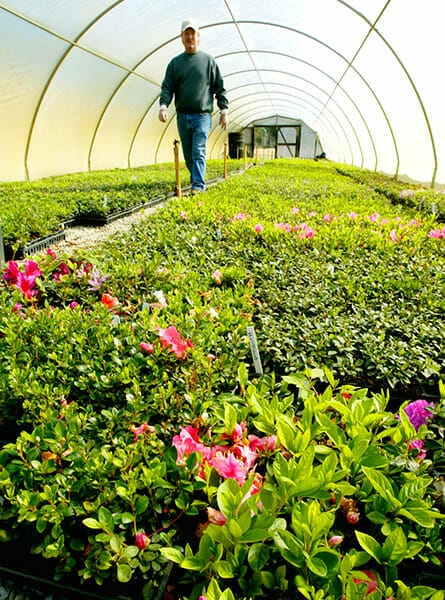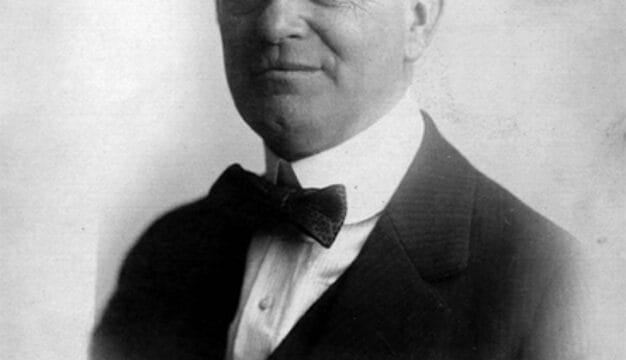Greenhouse and Floral Production in Alabama
 Greenhouse Poinsettias
Greenhouse production in Alabama began during the first half of the twentieth century by individuals with farming backgrounds who began growing vegetable seedlings for transplant outdoors as an alternative to traditional field crops. The market evolved sporadically, with farmers marketing their plants to home gardeners at roadside stands and agricultural stores. In the 1960s and early 1970s, the demand for flowering plants increased with the rise of the suburbs, and growers began building large, domed greenhouses covered in polyethylene plastic to protect crops from inclement weather in early spring. The flowering plants were initially grown in containers made from organic material, such as peat, and marketed to agricultural stores, florists, and early garden centers along with the bare-root vegetables. The mid- to late-1970s brought rapid growth of the industry in Alabama, with innovations in greenhouse technology and the introduction of plastic market flats that streamlined handling and shipping. Established companies expanded, and new companies began to spring up in the state as well. Today, greenhouse production is a multi-million-dollar industry in the state.
Greenhouse Poinsettias
Greenhouse production in Alabama began during the first half of the twentieth century by individuals with farming backgrounds who began growing vegetable seedlings for transplant outdoors as an alternative to traditional field crops. The market evolved sporadically, with farmers marketing their plants to home gardeners at roadside stands and agricultural stores. In the 1960s and early 1970s, the demand for flowering plants increased with the rise of the suburbs, and growers began building large, domed greenhouses covered in polyethylene plastic to protect crops from inclement weather in early spring. The flowering plants were initially grown in containers made from organic material, such as peat, and marketed to agricultural stores, florists, and early garden centers along with the bare-root vegetables. The mid- to late-1970s brought rapid growth of the industry in Alabama, with innovations in greenhouse technology and the introduction of plastic market flats that streamlined handling and shipping. Established companies expanded, and new companies began to spring up in the state as well. Today, greenhouse production is a multi-million-dollar industry in the state.
The Floral Industry
The Alabama floral industry is comprised of the wholesale greenhouse sector, the retail florist sector, and the retail garden-center sector. Wholesale greenhouse growers are the main production sector of industry. They receive propagation material such as seed, seedlings, and rooted cuttings from specialist propagators, largely in other states. These crops are grown through one or more production stages to a market quality size and then packed and shipped to the retail garden center sector. In Alabama, these businesses are mostly family owned and operated, with an acre or less of greenhouse production space. Statewide, there are 167 businesses, with the majority being those earning less than $100,000 annually. Most of these businesses are concentrated in areas of Alabama where they have easy shipping access to major metropolitan markets. For example, many growers are located in and around Anniston to take advantage of interstate highway access to Birmingham, Atlanta, and Chattanooga, although the two largest—Bonnie Plants and Young’s Plant Farm—are located in Bullock County and in Auburn, respectively.
The retail florist sector is comprised of traditional florists, who sell cut-flower products for weddings, funerals, holidays, occasions, and mass-market businesses, such as grocery stores and discount department stores. Up until the mid-1970s, most cut-flower products were purchased from small family-owned and -operated businesses, but when supermarkets and other large retailers recognized the opportunities in the cut-flower market, they gained a sizeable foothold in the market. This change was facilitated by large-scale imports of inexpensive cut flowers from other regions of the world, particularly South America. Despite these changes in the market, retail florists remain profitable enterprises by providing high-quality products and services and locating close to metropolitan areas, where their attributes are desired by consumers.
 Azaleas in a Semmes Nursery
The retail garden-center sector is comprised of traditional garden centers as well as mass-market businesses, such as grocery stores and discount department stores. These businesses provide a wide range of gardening products and services, including trees and shrubs, landscape design and maintenance services, bedding plants, potted flowering plants, gardening hardware, and chemicals. Like florists, traditional retail garden centers began experiencing competition from mass-market businesses as that business model gained traction in Alabama and the rest of the nation. Traditional garden centers have countered the competition by providing high-quality products and services that are often difficult to implement in a mass-market setting and by being located close to metropolitan areas.
Azaleas in a Semmes Nursery
The retail garden-center sector is comprised of traditional garden centers as well as mass-market businesses, such as grocery stores and discount department stores. These businesses provide a wide range of gardening products and services, including trees and shrubs, landscape design and maintenance services, bedding plants, potted flowering plants, gardening hardware, and chemicals. Like florists, traditional retail garden centers began experiencing competition from mass-market businesses as that business model gained traction in Alabama and the rest of the nation. Traditional garden centers have countered the competition by providing high-quality products and services that are often difficult to implement in a mass-market setting and by being located close to metropolitan areas.
Crops
Most of the crops grown in Alabama by greenhouse businesses and offered by garden centers are called bedding plants because they are intended to be planted in designated flower beds. Consumers who purchase bedding plants are paying for the convenience of buying started plants, rather than having to grow them from seed themselves. They also gain the benefit of getting a head start on the growing season by purchasing plants that are already large and in flower. The term “bedding plants” refers to a common method of production, marketing, and use of these products and does not refer to a taxonomic classification of plants.
In a national survey conducted by the U.S. Department of Agriculture in 2005, 57 percent of the bedding plants sold in the United States were among the 10 top-selling plants, but the remaining 43 percent, those in the “other” category, consisted of hundreds of varieties of annuals, perennials, biennials, herbs, ground covers, vegetables, small fruits, and a few woody plants. In fact, the fifth-highest-selling bedding plants were vegetable plants, consisting mainly of tomatoes and peppers. The most important market season for bedding plants in Alabama is the spring, from late March to early May, during which warm-season plants dominate. Many greenhouse businesses rely on this market period for much of their yearly income. The fall market season, from September to early November, is also important, however. Pansies and garden mums are the most important products during this season.
Typically, greenhouse growers start bedding plants as small seedlings in multi-celled plastic trays, called plug flats, or purchase them from specialist propagators. Growers may also purchase vegetative cuttings rooted in plug flats. These small plants are transplanted into plastic market flats (the main unit that is shipped) comprised of multiple market packs containing four, six, or eight plants. These market packs are the product unit that consumers select and purchase. Plants in final containers are placed in greenhouses and given near-optimum conditions of light, temperature, water, and fertilizer for rapid growth. Bedding plants are not shipped to the retail sector until they have one or more flowers open.
The Industry Today
As of 2005, the Alabama greenhouse production ranked 16th among the 50 U.S. states in wholesale value. Total wholesale value in Alabama exceeded $94 million in 2005, making a significant contribution to the Alabama economy. Of that total, bedding and garden plants were by far the largest crop category at $77 million. Other important crops in the state were poinsettias at $4,552,000 and garden mums at $4,470,000. Currently, the Alabama greenhouse industry is moving rapidly toward robotic mechanization of production and computer-based management of the greenhouse environment to minimize labor costs, reduce energy costs, and increase efficiency.



